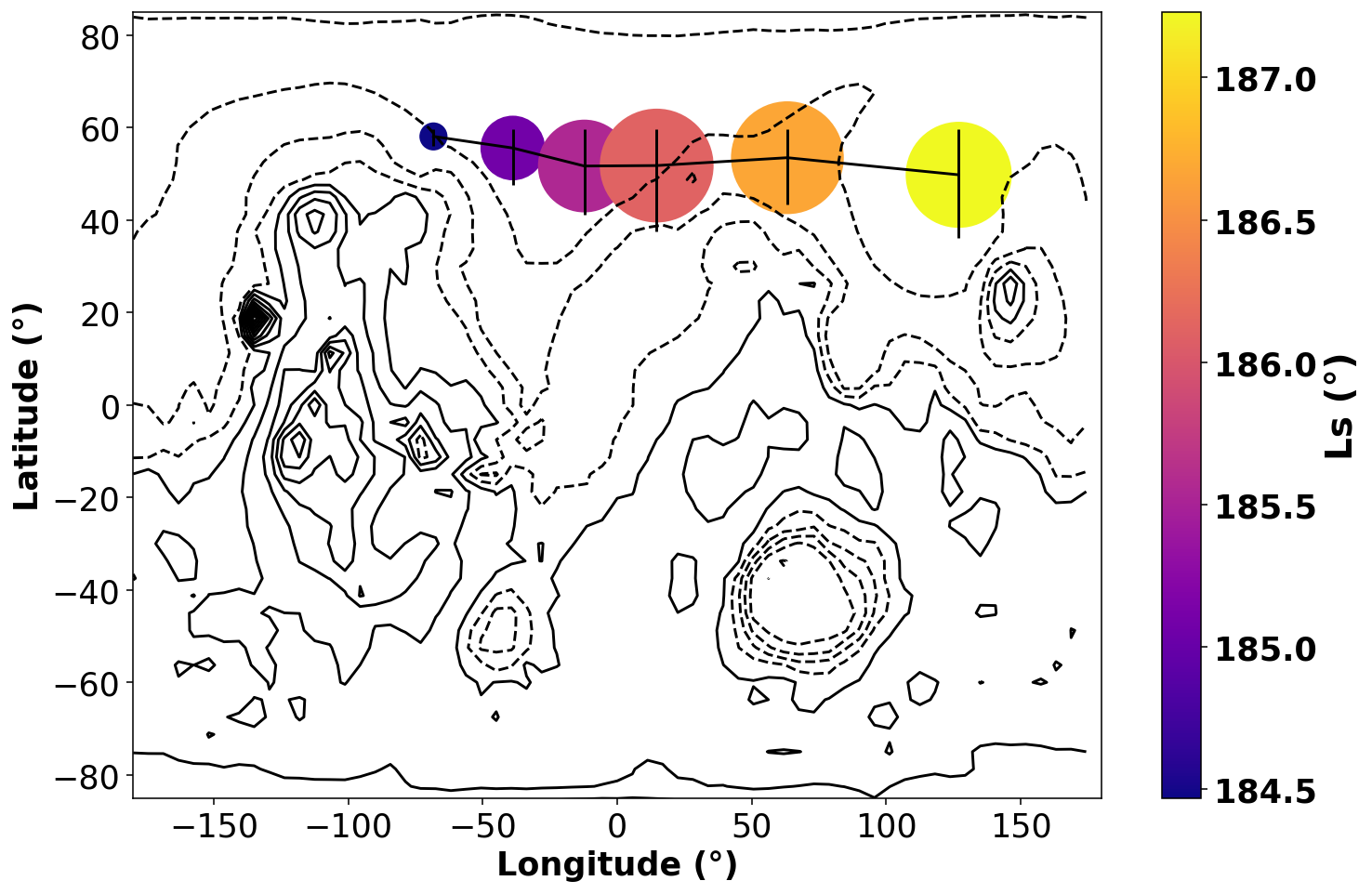- 1Freie Universität Berlin, Institute of Meteorology, Earth Sciences, Berlin, Germany (demetrius.ramette@fu-berlin.de)
- 2Laboratoire de Météorologie Dynamique, IPSL, Paris, France (ehouarn.millour@lmd.ipsl.fr)
- 3LESIA, Observatoire de Paris, Université PSL, Sorbonne Université, Université de Paris, CNRS, Meudon, France (tanguy.bertrand@obpsm.fr)
- 4Institut Pierre Simon Laplace, IPSL, Paris, France (antoine.bierjon@lmd.ipsl.fr)
Dust is a key component affecting the radiative budget of the Martian atmosphere. In order to achieve accurate numerical modelling of the Martian weather and climate, it is therefore crucial to understand the dynamics of Martian dust storms throughout their whole life cycle, from the injection to the deposition of dust [1]. However, our understanding of dust storm dynamics is still incomplete and simulations of the Martian dust cycle come with large uncertainties, especially concerning the transport of dust by model winds. The latter are difficult to validate, as in-situ or remote-sensing measurements of winds in the Martian atmosphere are rare or inexistent. How well do dust storm trajectories predicted by a Mars Global Climate Model match observed trajectories?
In this study, we use recently published observations [2, 3] of dust storm trajectories and dust storm simulations by the Mars PCM6 [4], in order to compare the direction and velocity of dust transport of individual dust storms. This will allow to identify strengths and weaknesses of the Mars PCM6 with respect to dust transport.
The Mars PCM in its newest version 6 [5, 6] is able to initiate a dust storm with a given dust scenario – based on maps of the observed column dust optical depth from [7] – and then let it freely evolve, following the large scale winds and other relevant physical processes. The Mars Dust Activity Database (MDAD, [2]) and the Mars Dust Storm Sequence Dataset (MDSSD, [3]) contain compilations of observed dust storms, based on high-resolution (0.1° x 0.1°) daily mosaics of wide-angle images from orbital cameras. Fig. 1 shows an exemplary trajectory of a dust storm member from the MDAD.
This new combination of model results and observations may further open opportunities to better understand the dynamics of Martian dust storms, especially concerning emission and deposition processes and, based on that, to improve dust cycle representation in the Mars PCM.
 Fig. 1: Plotting of the trajectory of an exemplary dust storm member during Mars Year 24 on a map of Mars, around Ls=185° (here: dust storm member m03_126 from the MDAD [2]). The size of the colored circles scales with the surface area of the dust storm and the color indicates the time of observation (solar longitude Ls, in degrees). The vertical black lines indicate the maximum latitudinal extension of the dust storm. The black broken line connects the individual positions of the dust storm centroid and thus indicates the evolution of its position over time. The contour lines (dashed and solid lines) represent the Martian topography with a line interval of 1500m. Here, we see that the dust storm originates in the Northern Hemisphere west of Acidalia Planitia and ends in Utopia Planitia. In this study, we want to compare these kind of tracks with model simulations.
Fig. 1: Plotting of the trajectory of an exemplary dust storm member during Mars Year 24 on a map of Mars, around Ls=185° (here: dust storm member m03_126 from the MDAD [2]). The size of the colored circles scales with the surface area of the dust storm and the color indicates the time of observation (solar longitude Ls, in degrees). The vertical black lines indicate the maximum latitudinal extension of the dust storm. The black broken line connects the individual positions of the dust storm centroid and thus indicates the evolution of its position over time. The contour lines (dashed and solid lines) represent the Martian topography with a line interval of 1500m. Here, we see that the dust storm originates in the Northern Hemisphere west of Acidalia Planitia and ends in Utopia Planitia. In this study, we want to compare these kind of tracks with model simulations.
[1] Kahre, M. A., Murphy, J. R., Newman, C. E., Wilson, R. J., Cantor, B. A., Lemmon, M. T., & Wolff, M. J. (2017). The Mars dust cycle. The atmosphere and climate of Mars, 18, 295.
[2] Battalio, M., & Wang, H. (2021). The Mars Dust Activity Database (MDAD): A comprehensive statistical study of dust storm sequences. Icarus, 354, 114059.
[3] Wang, H., Saidel, M., Richardson, M. I., Toigo, A. D., & Battalio, J. M. (2023). Martian dust storm distribution and annual cycle from Mars daily global map observations. Icarus, 394, 115416.
[4] Forget, F., Hourdin, F., Fournier, R., Hourdin, C., Talagrand, O., Collins, M., Lewis, S.R., Read P.L. & Huot, J. P. (1999). Improved general circulation models of the Martian atmosphere from the surface to above 80 km. Journal of Geophysical Research: Planets, 104(E10), 24155-24175.
[5] Forget, F., Millour, E., Bierjon, A., Delavois, A., Fan, S., Lange, L., Liu, J., Mathe, C., Naar, J., Pierron, T., Vandemeulebrouck, R., Spiga, A., Montabone, L., Chaufray, J.-Y., Lefèvre, F. Määttänen, A., Montmessin, F., Rossi, L., Vals, M., Gonzalez-Galindo, F., Lopez-Valverde, Wolff, M.J., Young, R., Lewis, S.R. & Read, P. L. (2022). Challenges in Mars Climate Modelling with the LMD Mars Global Climate Model, Now Called the Mars “Planetary Climate Model”(PCM). In Seventh international workshop on the Mars atmosphere: Modelling and observations.
[6] Millour, E., Bierjon, A., Forget, F., Spiga, A., Wang, C. and the Mars PCM Team, "Improving the vertical distribution of airborne dust in the Mars PCM", EPSC 2024
[7] Montabone, L., Forget, F., Millour, E., Wilson, R. J., Lewis, S. R., Cantor, B., Kass, D., Kleinböhl, A., Lemmon, L.T., Smith, M.D. & Wolff, M. J. (2015). Eight-year climatology of dust optical depth on Mars. Icarus, 251, 65-95.
How to cite: Ramette, D., Millour, E., Bertrand, T., Bierjon, A., and Schepanski, K.: Validation of Martian dust storm trajectories in the Mars PCM using observational datasets, Europlanet Science Congress 2024, Berlin, Germany, 8–13 Sep 2024, EPSC2024-231, https://doi.org/10.5194/epsc2024-231, 2024.